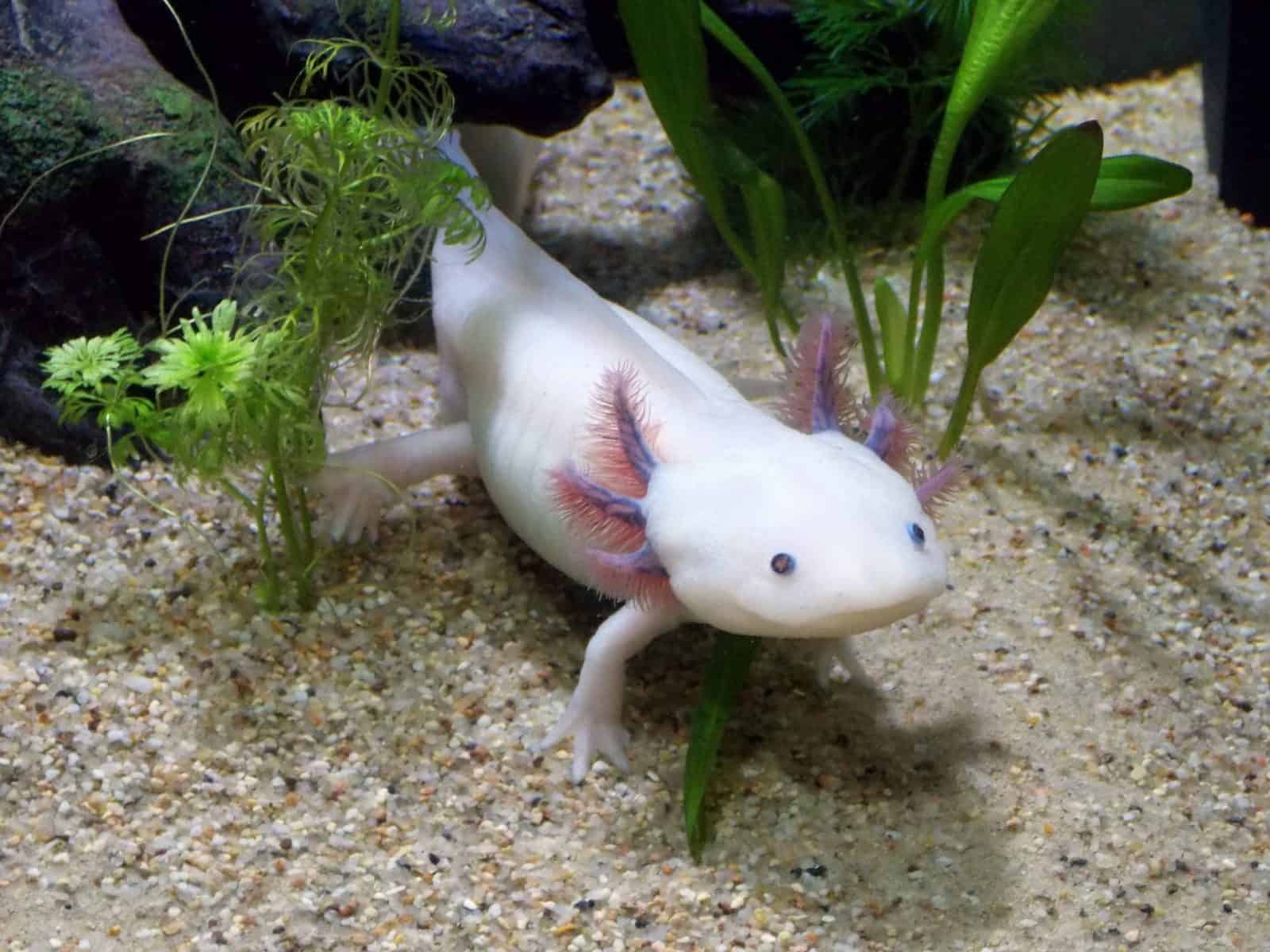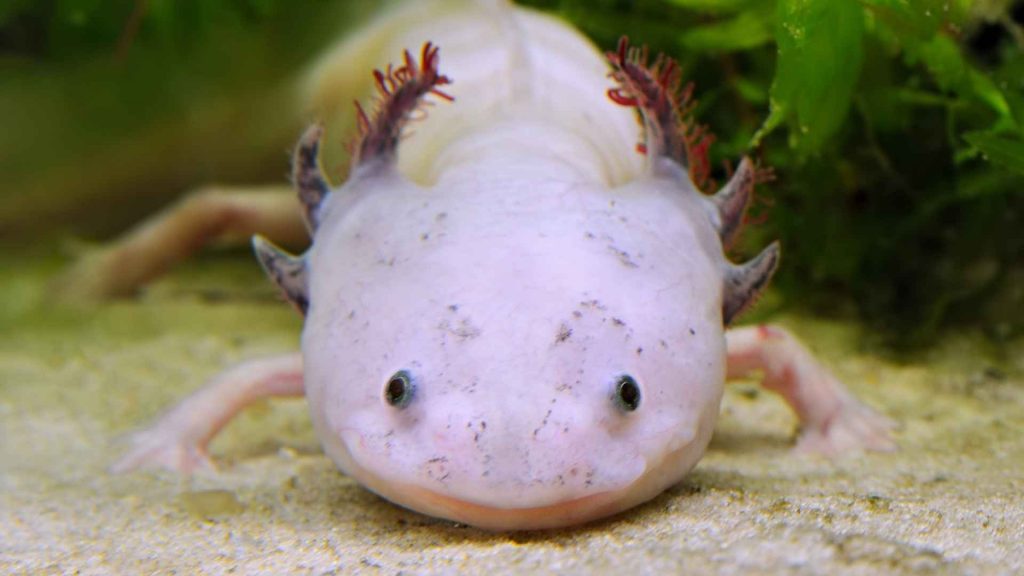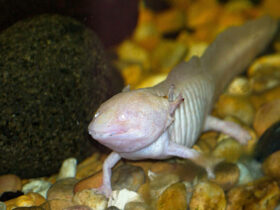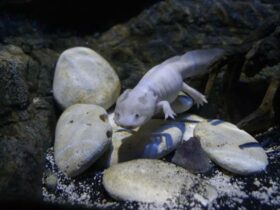
Contents
Can Axolotls Go On Land? – Introduction:

Axolotls have long fascinated scientific researchers and aquarium enthusiasts with their unique characteristics and remarkable regenerative abilities. These aquatic creatures, often called Mexican walking fish, are native to Mexico and are well-known for their ability to regenerate lost body parts, including limbs, spinal cord, and even parts of their heart and brain. However, conflicting information and misconceptions abound when it comes to their ability to venture onto land. This article will explore whether axolotls can adapt to a terrestrial environment.
Can Axolotls live on land? : https://m.youtube.com/watch?v=VukWRcidyaE&pp=ygUYQ2FuIEF4b2xvdGxzIEdvIE9uIExhbmQ_
Understanding Axolotls:
Before delving into the land adaptation capabilities of axolotls, it is important to understand their natural habitat and physical characteristics. Axolotls are amphibians that belong to the family Ambystomatidae. They typically inhabit freshwater lakes, specifically Lake Xochimilco and Lake Chalco in Mexico.
Aquatic Adaptation:
Unlike other amphibians that undergo metamorphosis from larval to adult stage, axolotls retain their juvenile characteristics and remain permanently aquatic. They have fully functional gills, specialized fin-like limbs, and a streamlined body design, making them well-suited for life in the water. Furthermore, axolotls possess a unique lung-like organ called a lung sac, which enables them to extract oxygen from the air when submerged for extended periods.
Limited Terrestrial Abilities:
While it is true that axolotls possess rudimentary lungs and can gulp air when needed, these organs are not sufficient to support long-term survival on land. Unlike fully terrestrial amphibians like frogs or toads, axolotls lack certain adaptations, such as robust limbs, a strong skeleton, and the ability to secrete a protective waxy coating to prevent dehydration. Their delicate skin, which helps them exchange gases effectively in water, becomes a liability on land due to increased vulnerability to drying out.
Experimental Cases:
Although there have been anecdotal reports of axolotls venturing onto land for brief periods, it is important to note that these instances were highly unusual and often involved stressed or injured individuals seeking refuge. Some researchers have experimented with artificially induced land adaptations by exposing axolotls to gradually desiccating environments. These experiments showed a limited ability to tolerate the land for short periods, but not without significant stress or health consequences.
Conserving Their Aquatic Habitat:
Given their limited terrestrial capabilities, it is crucial to prioritize the preservation and conservation of axolotls’ natural aquatic habitat. Habitat loss, water pollution, and the introduction of non-native species have resulted in a steep decline in wild axolotl populations. The focus should be on preserving these unique creatures’ native environments, maintaining water quality, and preventing the spreading of diseases that could further threaten their survival.
As we have seen, axolotls are not your average amphibians. They possess unique physiological adaptations that allow them to survive brief periods out of water. However, it’s important to note that these instances are highly unusual and often involve stressed or injured individuals seeking refuge. So, if you were hoping to see an axolotl strolling on land like a lizard, I’m sorry to disappoint you.
Some researchers have conducted experiments to induce land adaptations in axolotls. They exposed these aquatic creatures to gradually desiccating environments, hoping to unlock hidden terrestrial capabilities. Surprisingly, the experiments showed a limited ability for the axolotls to tolerate land for short periods. However, it should be mentioned that this came at a cost – significant stress and health consequences were observed.
Preserving the Axolotl’s Native Environments: A Top Priority
Habitat loss, water pollution, and the introduction of non-native species have all contributed to the decline of the axolotl population. These unique creatures, known for their regenerative abilities and adorable appearance, now face an uncertain future. However, there is hope if we take immediate action to protect their natural habitats and implement measures to prevent further harm.
Now that we’ve established that venturing onto land is not a natural or viable option for axolotls, what does this mean for their conservation? Well, it means that we need to prioritize the preservation and conservation of their natural aquatic habitat. Unfortunately, wild axolotl populations have experienced a steep decline due to habitat loss, water pollution, and the introduction of non-native species.
Preserving these unique creatures’ native environments should be our top priority. This means maintaining water quality and preventing further damage from human activities, such as pollution and habitat destruction. Additionally, efforts should be made to prevent the introduction of non-native species into their habitats, as they can disrupt the delicate balance of ecosystems and threaten native axolotl populations.
Furthermore, disease prevention is crucial for axolotl survival. Diseases can spread easily among these vulnerable amphibians and potentially wipe out entire populations. It is, therefore, essential to implement measures such as quarantine procedures and strict regulations on the trade and movement of axolotls to prevent the spread of diseases.
Maintaining Water Quality: A Vital Step
One of the key factors in preserving axolotls’ native environments is ensuring water quality. Pollution from human activities such as industrial waste, agricultural runoff, and improper disposal of chemicals poses a significant threat to these aquatic creatures. The toxins in polluted water can harm the axolotls’ delicate skin and interfere with their physiological processes.
To combat this issue, we must take collective responsibility by adopting eco-friendly practices in our daily lives. Proper waste management, responsible use of chemicals, and reducing pollution from industries are all steps that can help maintain water quality. Additionally, implementing effective filtration systems in aquariums and enclosures where axolotls are kept in captivity can provide them with a safe home away from home.
Preventing the Introduction of Non-Native Species
Another significant threat to axolotls is introduction of non-native species into their habitats. When foreign species are introduced, they can disrupt the delicate balance of ecosystems and outcompete native species for resources. This competition for food and shelter can significantly impact axolotl populations.
To mitigate this risk, strict regulations should be implemented to control the trade and movement of non-native species. Additionally, educational campaigns can raise awareness among pet owners about responsible ownership and discourage releasing unwanted pets into natural habitats. By preventing the introduction of non-native species, we can protect the unique ecosystems axolotls rely on for survival.
Disease Prevention: A Critical Component
Disease prevention plays a vital role in ensuring the long-term survival of axolotls. These vulnerable creatures are particularly susceptible to diseases that can spread rapidly among their populations. A single outbreak could potentially wipe out entire communities of axolotls.
To combat this, quarantine procedures should be implemented for any new axolotls introduced into captivity or native environments. This precautionary measure can help isolate and treat any individuals carrying diseases before they can infect other axolotls.
Furthermore, strict regulations on the trade and movement of axolotls should be enforced to prevent the spread of diseases across different regions. This includes regular health checks and screenings to detect any potential threats and address them promptly.
While axolotls possess certain physiological adaptations that allow them to survive brief periods out of the water, it is clear that their true place is in their aquatic habitats. Their delicate skin, lack of terrestrial adaptations, and dependency on water make them ill-suited for life on land. We must recognize this fact as we strive to protect these remarkable creatures.
By studying and admiring the axolotl, we appreciate its unique biology and extraordinary regenerative abilities. We are responsible for preserving their natural habitats and ensuring their long-term survival in the environment they have evolved to thrive in.
Let’s rally together to protect these fascinating amphibians and the irreplaceable ecosystems they call home. By taking action against habitat loss, preventing water pollution, controlling the introduction of non-native species, and implementing disease prevention measures, we can secure a brighter future for the axolotl population.
Together, we can make a difference and ensure that future generations will be privileged to witness these incredible creatures thriving in their native environments. Let’s unite our efforts to preserve the axolotl and celebrate the beauty of biodiversity.
Conclusion:
While axolotls possess certain physiological adaptations that allow them to survive brief periods out of the water, venturing onto land is not a natural or viable option for these amphibians. Their delicate skin, lack of terrestrial adaptations, and dependency on their aquatic habitat make them ill-suited for terrestrial life. As we continue to study and admire these fascinating creatures, let us work towards preserving their natural habitats and ensuring their long-term survival in the environment they have evolved to thrive in.
More Links :
Is an Axolotl a Fish? Understanding the Differences between Axolotls and Fish in ’23! : https://adoptanim.com/is-an-axolotl-a-fish/
Unfertilized Axolotl Eggs: https://adoptanim.com/unfertilized-axolotl-eggs/





Leave a Reply